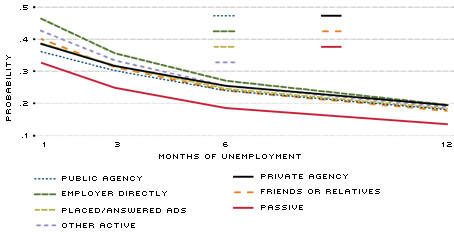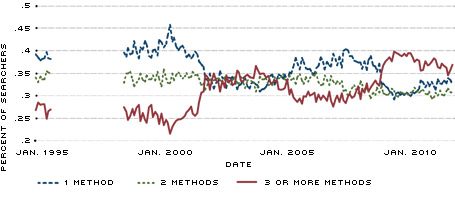Job Searching: Some Methods Yield Better Results than Others
Despite the end of the recession nearly five years ago, many of the unemployed have not found a job. The economic recovery has been marked by both a stubbornly high unemployment rate and an unprecedented increase in the duration of unemployment.[1] Does the method of searching have a large impact on the likelihood of finding a job? Would the long-term unemployed improve their odds by changing the way they search? In this article, we delve into the methods by which job seekers look for jobs, how the methods vary in efficacy and how the distribution of methods changes over the business cycle.
We found that job seekers report using more search methods during times of recession than during economic expansion. It appears that the unemployed broaden their search when times become tough, perhaps to compensate for the negative effect of the recession on the likelihood of finding a job using any particular method.
We also found that some search methods are more effective than others, which has implications for inequality and policy. If the most effective method of finding a job were from contact with one's friends and family, the well-connected would have a significant advantage. If public employment agencies were more effective, policymakers could improve labor market conditions by encouraging their use. As we show, those who use their network connections actually find jobs at a slower rate than the average job seeker. The most effective method is to directly contact potential employers.
In addition, we found that the efficacy of job-search methods changes as the duration of unemployment increases. Previous evidence suggests that job applicants in a long unemployment spell are less likely to be invited to interview than those with shorter durations.[2] Therefore, one might suspect that using employment services could be more effective than direct applications for the long-term unemployed. However, our evidence suggests otherwise; at long durations, the finding rates of all the methods converge on one another.
The Current Population Survey (CPS) is the main source of information on unemployment dynamics in the U.S. Because this is real-world data, it has an important limitation: An individual chooses his or her search method, rather than being randomly assigned. This means that when we observe that those choosing one type of search find jobs faster than those who choose another, it may be because one type of search is more effective, but it also may be in part because those who quickly find jobs choose one method and others choose another. With this caveat in mind, we used this dataset from 1976 to 2011 to find the frequency at which job seekers use each method, how the method affects the likelihood of finding a job and how the number of methods used changes over time.
Use of Search Methods
Each month, every unemployed CPS respondent answers the question "What have you been doing in the last four weeks to find work?" The survey allows respondents to indicate one or more methods from a list of seven or, after 1994, 13.[3] The methods are broadly categorized as either "active" or "passive." An active job search method directly brings potential employers and employees into contact and could result in a job offer without any further action from the job seeker. A passive method, such as attending a job training program or updating a resume, may eventually improve the likelihood of finding a job but does not bring job seekers and employers into direct contact.[4] To be considered unemployed, rather than out of the labor force, respondents must use at least one active method. To analyze the data from 1976 to 2011, we reclassified responses after 1994 into the pre-1994 scheme with the new active methods appearing after 1994 reclassified as "other." New passive methods were placed into the "nothing" category, which we relabeled "passive."
Table 1 shows the percentage of total job searches conducted over the entire period that used each method. Unsurprisingly, job seekers most commonly reported contacting potential employers directly: Nearly two-thirds of all job searches taking place from 1976 to 2011 involved direct contact. In addition to being the most common, this method was also among the most successful. Only 6.7 percent of job seekers reported using a private employment agency to find work. Those who did fared relatively poorly; this method had one of the lowest job-finding rates in the first month of unemployment, second only to using a public employment agency.
Many job seekers reported using multiple methods, some of which were more likely to be used together than others. Table 2 shows the fraction of job seekers who used the method listed in the row if they had also used the method listed in the column. For instance, among those using passive methods of search, only 46 percent also directly contacted potential employers. Thirty-four percent of those who talked to friends and family also placed or answered job ads, more often than an average searcher. Interestingly, those who reported using a public employment agency were also more likely than average to have tried a private employment agency.
Convergence of Finding Rates
The data reflect a long-observed feature of the labor market: The longer an individual is unemployed, the less likely he or she is to find a job.[5] We also found that the longer a person is unemployed, the less it matters which method is used to search for a job: All the finding rates fall and converge with one another.
In the first month of unemployment, the job-finding rates show a fair amount of dispersion, ranging from 46 percent for those contacting an employer directly to 32 percent for those using passive search methods.
However, after a year of unemployment, the difference is only about 5 percentage points. If passive methods are excluded, the difference between the most- and least-productive job-search methods is only about 2 percentage points. Figure 1 illustrates these two features of the data: (1) that the likelihood of finding a job falls with the length of unemployment, and (2) that the method of search has little impact for the long-term unemployed.
Number of Searches
Figure 2 shows the number of different search methods respondents reported using in the previous four weeks. As other economists have noted,[6] this is an important statistic because it can serve as a proxy for search effort. The number of methods an individual uses increases as economic conditions worsen; the number has gradually trended up since 1994.[7] During the prosperous late 1990s, job seekers most often reported using only one method to find a job.
However, during the recession of the early 2000s, when jobs were scarcer, the percentage of searchers who used only one method fell, while the percentage using three or more methods rose sharply. The percentage using three or more methods remained elevated through the first half of the decade, but fell slightly as economic conditions improved mid-decade. However, the fraction of respondents reporting three or more methods shot up again during the recession of the late 2000s as unemployment increased and remained elevated to the end of our sample (in the fourth quarter of 2011). Interestingly, the percentage using two methods remained quite stable over time.
The Rate at Which Unemployed Workers Find Employment

SOURCES: Current Population Survey and authors' calculations.
NOTE: This figure shows the probability that an individual will find a job using a given search method as a function of the length of time that the individual has been unemployed. A higher point indicates a greater probability of finding a job. The downward sloping line indicates that the long-term unemployed are the least likely to find a job using any method.
Number of Methods Used Over Time

SOURCES: Current Population Survey and authors' calculations.
Endnotes
- For average duration of unemployment, see http://research.stlouisfed.org/fred2/series/UEMPMEAN. For median duration of unemployment, see http://research.stlouisfed.org/fred2/series/UEMPMED. For a history of the civilian unemployment rate, see http://research.stlouisfed.org/fred2/series/UNRATE. [back to text]
- See, for example, Kroft, Lange and Notowidigdo. [back to text]
- Prior to 1994, the only choices were: contacting a public employment agency, contacting a private employment agency, contacting a potential employer directly, contacting friends or relatives, placing or answering ads, "nothing," and using other methods. The CPS' redesign in 1994 affected the respondents' menu of choices, expanding them from seven to 13. This makes comparison between these periods difficult for some categories. [back to text]
- See Polivka and Rothgeb for a discussion on the definition of active and passive methods in the CPS. [back to text]
- See, for example, Clark and Summers. [back to text]
- See Shimer. [back to text]
- We could not compare the number of search methods before and after the 1994 redesign because the number of potential choices changed by so much. We omitted data for some months because of another coding inconsistency. [back to text]
References
Clark, Kim; and Summers, Lawrence. "Labor Market Dynamics and Unemployment: A Reconsideration." Brookings Papers on Economic Activity, 1979, Vol. 10, No. 1, pp. 13-72.
Kroft, Kory; Lange, Fabian; and Notowidigdo, Matthew. "Duration Dependence and Labor Market Conditions: Evidence from a Field Experiment." Quarterly Journal of Economics, Vol. 128, No. 3, August 2013, pp. 1,123-67.
Krueger, Alan; and Mueller, Andreas. "Job Search, Emotional Well-Being, and Job Finding in a Period of Mass Unemployment: Evidence from High-Frequency Longitudinal Data." Brookings Papers on Economic Activity, Spring 2011, Vol. 42, No. 1, pp. 1-81.
Polivka, Anne E.; and Rothgeb, Jennifer M. "Overhauling the Current Population Survey: Redesigning the CPS Questionnaire." Monthly Labor Review, September 1993, Vol. 116, No. 10, pp. 10-28.
Shimer, Robert. "Search Intensity." Unpublished paper, 2004.
Views expressed in Regional Economist are not necessarily those of the St. Louis Fed or Federal Reserve System.
For the latest insights from our economists and other St. Louis Fed experts, visit On the Economy and subscribe.
Email Us


